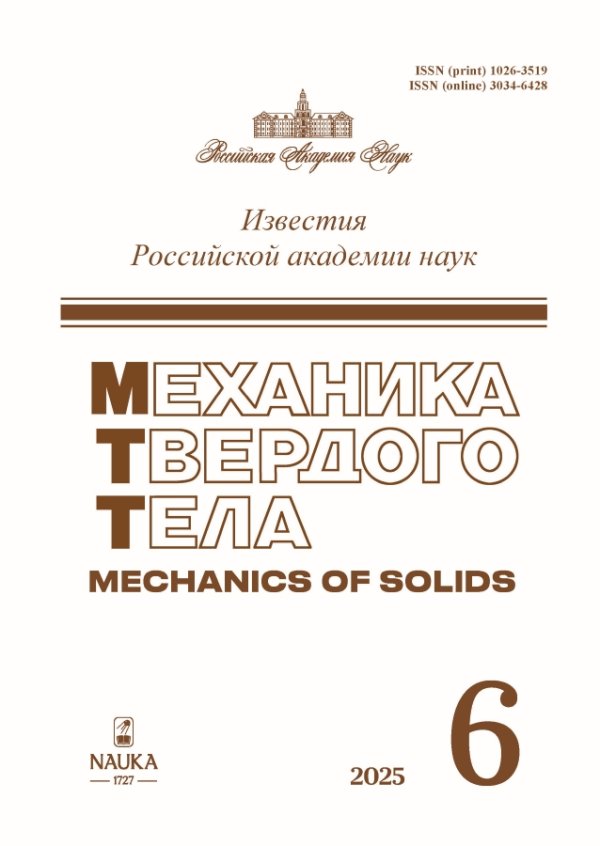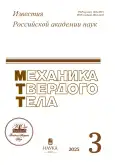BARYCENTRIC COORDINATES IN THE EQUILIBRIUM PROBLEM OF A HEAVY ROUGH TRIANGLE SUSPENDED ON A PIN
- Authors: Nikonova E.A1
-
Affiliations:
- FRC CSC RAS
- Issue: No 3 (2025)
- Pages: 128-138
- Section: Articles
- URL: https://journal-vniispk.ru/1026-3519/article/view/304226
- DOI: https://doi.org/10.31857/S1026351925030071
- EDN: https://elibrary.ru/azwuid
- ID: 304226
Cite item
Abstract
A planar equilibrium problem of a heavy homogeneous thin wire triangle suspended on a thin horizontal nail is considered. The existence of equilibrium positions and their dependence on the coefficient of friction and the lengths of the sides of the triangle are studied under the assumption of the presence of a dry friction force acting between the triangle and the nail. The problem is solved in barycentric coordinates associated with the vertex system of the triangle in question. The equilibrium condition is written in a form that allows a cyclic shift of the indices of the quantities included in it to obtain an equilibrium condition for any of the sides of the triangle with which it contacts the nail.
Keywords
About the authors
E. A Nikonova
FRC CSC RAS
Author for correspondence.
Email: nikonova.ekaterina.a@gmail.com
References
- Phear J.B. Elementary Mechanics. Cambridge: MacMillan. 1850. 252 p.
- Walton W.A. Collection of problems in illustration of the principles of theoretical mechanics. 2nd ed. Cambridge: Deighton, Bell, and Co. 1855. 470 p.
- Appell P. Traité de Mécanique Rationnelle. Tome I. Paris: Gauthier-Villars, 1893. 560 p. [Appell P. Theoretical Mechanics, V. 1: Statics. Dynamics Points. Moscow: Fizmatlit, 1960. 516 p. (in Russian)].
- Wittenbauer F. Aufgaben aus der Technischen Mechanik. Berlin: Springer. 1907. 392 p.
- Routh E.J. A Treatise on Analytical Statics, with Numerous Examples. 2nd ed. Cambridge University Press, 1909. 392 p.
- Bukhholts N.N., Voronkov I.M., Minakov A.P. Collection of problems in theoretical mechanics. 3rd ed. M.–L.: GITTL. 1949. 276 p. (in Russian).
- Rosenblat G.M. Dry friction in problems and solutions. Moscow–Izhevsk: Publishing house “RCD”, 2009. 52 p. (in Russian).
- Ivanov A.P., Fundamentals of the Theory of Systems with Friction. Moscow–Izhevsk: Publishing house “RCD”, 2011. 304 p. (in Russian).
- Sumbatov A.S., Yunin Ye.K. Selected Problems in the mechanics of systems with dry friction. M.: Fizmatlit, 2013. 200 p. (in Russian).
- Ivanov A.P. The stability of equilibrium in systems with friction // Journal of applied mathematics and mechanics. 2007. V. 71. № 3. P. 385–395. https://doi.org/10.1016/j.jappmathmech.2007.07.010
- Ivanov A.P. Extremum property of constraint reactions // J. Appl. Math. Mech. 2012. V. 76. № 2. P. 142–153. https://doi.org/10.1016/j.jappmathmech.2012.05.003
- Ivanov A.P. The equilibrium of systems with dry friction // J. Appl. Math. Mech. 2015. V. 79. № 3. P. 217–228. https://doi.org/10.1016/j.jappmathmech.2015.09.002
- Ivanov A.P. On the equilibrium of magic stones // Mech. Solids. 2018. V. 53. № S(2). P. 26–31. https://doi.org/10.3103/S0025654418050084
- Genda A., Stepan G. On the stability of bodies suspended asymmetrically with an inelastic rope // Acta Mechanica. 2023. V. 234. P. 3009–3018. https://doi.org/10.1007/s00707-023-03546-x
- Burov A.A., Nikonov V.I. On the equilibria of a heavy hoop suspended on a nail // Mech. Solids. 2024. V. 59. № 1. P. 11–19. https://doi.org/10.1134/S0025654423601106
- Balk M.B., Boltyanskii V.G. Geometry of Masses. M.: Nauka, 1987. 160 p. (in Russian).
- Yaglom, I.M. Population genetics and Geometry. M.: Kvant. 1986. № 4. P. 5–11 (in Russian).
- Firstov V.E., Firstov V.V. Archimedova the concept of the barycenter and the quantitative analysis of pictorial images using IKT “BARYCOLOR” // Modern information technologies and IT education. 2015. V. 11. № 1. P. 410–420 (in Russian).
- Farouki R.T. The Bernstein polynomial basis: A centennial retrospective // Computer Aided Geometric Design. 2012. V. 29. № 6. P. 379–419. https://doi.org/10.1016/j.cagd.2012.03.001
- Hormann K., Sukumar N. Generalized barycentric coordinates in computer graphics and computational mechanics. New York: CRC Press. 2017. 338 p.
- Makhmudov K., Mitani Y., Kusuda T. Interpolation of climatic parameters by using barycentric coordinates // World Journal of Environmental Engineering. 2015. V. 3. № 1. P. 1–6. https://doi.org/10.12691/wjee-3-1-1
- Nikonov V.I. Relative equilibria in the motion of a triangle and a point under mutual attraction // Moscow University Mechanics Bulletin. 2014. V. 69. № 2. P. 44–50. https://doi.org/10.3103/S0027133014020034
- Jakubiak J. On barycentric coordinates in control of a thruster driven spacecraft // Proceedings of 13th APCA International Conference on Automatic Control and Soft Computing (CONTROLO). Ponta Delgada, Azores, Portugal: IEEE. 2018. P. 165–170. https://doi.org/10.1109/CONTROLO.2018.8516405
- Burov A.A., Munitsyna M.A., Nikonova E.A., Shalimova E.S. Selected problems of mechanical systems with friction: Routh problems. M.: IP Vorontsov M.Y. 2024. 112 p.
- Nikonov V.I. The existence and stability of steady configurations in the problem of the motion of a wire triangle and a point mass under the mutual attraction // J. Appl. Math. Mech. 2015. V. 79. № 3. P. 229–236.
- Schleicher D. John Conway: The Man Who Played Mathematics // Math. Intel. 2021. V. 43. P. 79–91. https://doi.org/10.1007/s00283-021-10123-4
- Gardner M. The fantastic combinations of John Conway’s new solitaire game “life” // Scientific American. 1970. V. 223. P. 120–123. https://doi.org/10.1038/scientificamerican1070-120
- Capitán F.J.G. Barycentric Coordinates // Int. J. Comput. Discovered Math. 2015. P. 32–48.
- Burov A.A. On Particularities of the realization of unilateral constraints with piecewise smooth boundaries // Russian Journal of Nonlinear Dynamics. 2024. V. 20. № 4. P. 481–491. https://doi.org/10.20537/nd241201
Supplementary files










